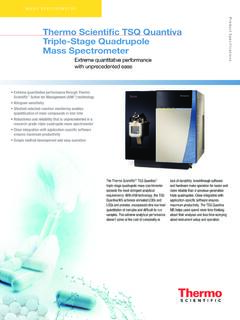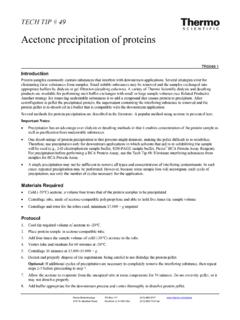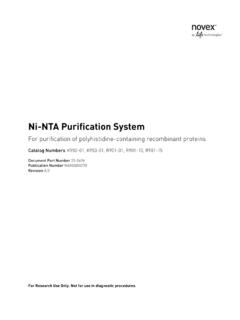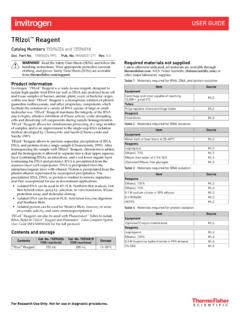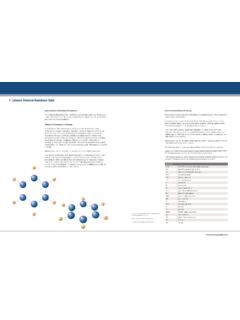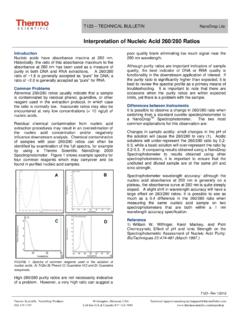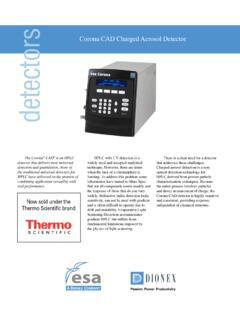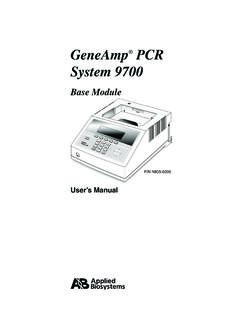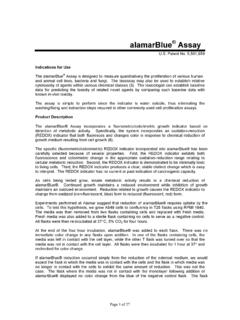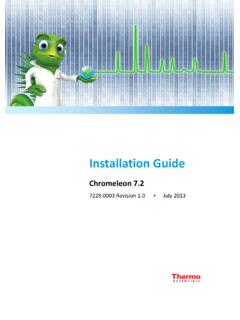Transcription of PROTOCOL PowerUp SYBR Green Master Mix Guidelines for ...
1 PROTOCOL PowerUp sybr Green Master Mix Guidelines for comparing sybr Green Master mixesTake the Master mix challenge compare your current Master mix to Applied Biosystems PowerUp sybr Green Master Mix using this simple PROTOCOL . In our own experiments, we found that PowerUp sybr Green Master Mix outperformed other Master mixes when comparing specificity, PCR efficiency, dynamic range, and precision over multiple PROTOCOL is for the comparison of PowerUp sybr Green Master Mix to one other Master mix using 20 L reactions in triplicate. Adjust volumes as Prepare enough Master mix for 26 x 20 L reactions for each qPCR Master mix to be tested, according to the volumes in the table below.
2 Mix thoroughly. DilutionTemplateNuclease-free waterUndiluted40 L of 20 ng/ L DNA 10 14 L of undiluted DNA36 L10 24 L of 10 136 L10 34 L of 10 236 L10 44 L of 10 336 L10 54 L of 10 436 L10 64 L of 10 536 LComponentPowerUp sybr Green Master MixMaster mix for comparisonqPCR Master mix, 2X260 L 260 LForward primer, 10 M26 L*Manufacturer s recommendationReverse primer, 10 M 26 L* Manufacturer s recommendationNuclease-free water78 L (final volume 390 L)Adjust to 390 L* Volumes shown are for 500 nM primer. The recommended primer concentration for PowerUp sybr Green Master Mix is 300 800 Guidelines Use the manufacturer s recommended primer and template DNA concentrations Use the manufacturer s recommended thermal cycling parameters Run a standard curve to compare PCR efficiency, sensitivity, dynamic range, and precision Run reactions in triplicate to measure reproducibility Perform a melt curve to analyze specificityReaction preparation1.
3 Prepare 10-fold dilution series of Pipet 15 L of the PowerUp sybr Green mix prepared in step 2 to each well of a 96-well optical plate according to the plate map below. 4. Pipet 5 L of the indicated dilution from step 1 into each well of the plate according to the plate map below. For no-template control (NTC) reactions, use 5 L of nuclease-free Repeat steps 3 4 for the other Master mix to be compared, using a new plate. Reactions can be loaded on the same plate if the thermal protocols are Mix the components thoroughly. Seal the plates, and briefly centrifuge to remove any bubbles. real - time PCR1. Place the plate in the Set the thermal cycling conditions. For PowerUp sybr Green Master Mix, use one of the following conditions.
4 Standard cycling (for most instruments and primer Tm 60 C) fast cycling (for Applied Biosystems ViiA 7, QuantStudio , 7500 fast , StepOne , and StepOnePlus instruments and primer Tm 60 C)123456789101112 AUndilutedUndilutedUndilutedB10 110 110 1C10 210 210 2D10 310 310 3E10 410 410 4F10 510 510 5G10 610 610 6 HNTCNTCNTCStepTemperatureTimeCyclesUDG activation50 C2 minHoldPolymerase activation95 C2 minHoldDenaturation95 C15 sec40 Annealing/extension60 C*1 min* For primers with Tm <60 C, please refer to the PowerUp sybr Green Master Mix instruction activation50 C2 minHoldPolymerase activation95 C2 minHoldDenaturation95 C1* or 3 sec40 Annealing/extension60 C 30 sec* For ViiA 7 or QuantStudio instruments.
5 For 7500 fast , StepOne, or StepOnePlus instruments. For primers with Tm <60 C, please refer to the PowerUp sybr Green Master Mix instruction manual. Include conditions for melt curve analysis after the PCR stage. On Applied Biosystems instruments, use the default continuous melt curve setting, which on most newer instruments are: For Applied Biosystems instruments, use the following settings:Experiment type: Standard curveReagent: sybr Green reagentsReporter: SYBRQ uencher: NonePassive reference dye: ROX Ramp speed: Standard or fast (choose the corresponding thermal cycler profiles in step 2 above) Melt curve ramp increment: Continuous See the instrument instruction manual for more information or if using a different Run the plate.
6 Repeat the run setup for the other Master mix being tested using the manufacturer s recommended thermal cycling analysisIn most qPCR systems, the data can be analyzed by the qPCR system and amplification efficiency: The amplification efficiency is calculated using the slope of the regression line of the standard curve. A slope of indicates optimal 100% PCR amplification efficiency. Reactions with efficiencies of 100% 10% over a broad dynamic range are needed to reliably use the Ct method for gene expression value (correlation coefficient): The R2 value is a measure of the closeness of fit between the regression line and the individual Ct data of the standard curve reactions.
7 A value of indicates a perfect fit between the regression line and the data. An R2 value > is deviation (precision): Calculate the standard deviation of the Ct values for each dilution. To be able to quantify a 2-fold dilution with 95% confidence, the standard deviation of a dilution should be Melt curve (specificity): View the melt curve using a derivative reporter plot (a plot of derivative reporter ( Rn) vs. temperature). A single peak indicates specific amplification, whereas multiple peaks or shoulders indicate nonspecific amplification or primer-dimer formation. StageStepRamp rateTemperatureTimeMelt curve stageStep C/sec95 C15 secStep C/sec60 C1 minStep 3 (dissociation) C/sec95 C15 secCaution: Don t be fooled by lower Ct values when comparing Master mixes.
8 The only way to compare the sensitivity and performance of two Master mixes is by performing a dilution series and examining the amplification efficiency, linearity, and precision across the dilution out more at Research Use Only. Not for use in diagnostic procedures. 2015 Thermo Fisher Scientific Inc. All rights reserved. All trademarks are the property of Thermo Fisher Scientific and its subsidiaries unless otherwise specified. CO210714 0915
